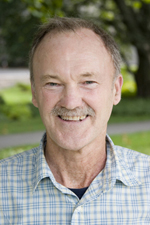2014 Monie A. Ferst Award
Professor Hutchinson received his BS in engineering  mechanics from Lehigh University in 1960 and his PhD in mechanical engineering from Harvard University in 1963. After a year as a research fellow at the Technical University of Denmark, he joined Harvard University as an assistant professor and was promoted to associate professor in 1968 and Gordon McKay Professor in 1969. In 2000 he became the Abbott and James Lawrence Professor at Harvard University, and has been the Abbott and James Lawrence Research Professor since 2012.
mechanics from Lehigh University in 1960 and his PhD in mechanical engineering from Harvard University in 1963. After a year as a research fellow at the Technical University of Denmark, he joined Harvard University as an assistant professor and was promoted to associate professor in 1968 and Gordon McKay Professor in 1969. In 2000 he became the Abbott and James Lawrence Professor at Harvard University, and has been the Abbott and James Lawrence Research Professor since 2012.
Hutchinson is an internationally renowned scholar in solid mechanics. For half a century, he has defined many of the most exciting frontiers of research. His enormous and lasting impact is amply confirmed by citations of his work. Google Scholar lists him as one of the most cited researchers in solid mechanics, with a total citation of 55,179 and an h-index of 114.
His name is firmly attached to structural instability. His papers on the instability of thin elastic shells showed that their load-carrying capacities are remarkably sensitive to imperfections. He later expanded this work to materials capable of large and plastic deformation. His analysis of the budging of a long balloon is a prototype of the studies of a large range of phenomena. His work on wrinkling of hard films on soft substrates has led to an extremely active field of research. The phenomena are ubiquitous in nature and in engineering, and have found significant applications in the emerging field of stretchable electronics.
His name is also firmly attached to fracture mechanics. He was the co-discoverer of what are now called the HRR fields (H for Hutchinson), which laid the foundation of the nonlinear fracture mechanics. Together with his collaborators, he has also developed the concepts of tearing stability, the theory of transformation-toughening ceramics, the theory of toughness due to the synergy between crack bridging and background dissipation, a theory of high-speed propagation of a crack in a viscoplastic material such as steel, the theory of fracture in ceramic-matrix composites, and of fracture in layered materials. These theories have become prototypes for the understanding of the toughening of other brittle materials, such as hydrogels. His work has made permanent impact on many practical problems involving fracture and delamination in the aerospace and microelectronic industries.
He has also made seminal contributions to the theory of plastic deformation in metals. He did pioneering work on the prediction of macroscopic plastic stress-strain relations for polycrystalline metals in terms of single-crystal plastic flow laws for their individual grains. In recent years, he led the development of the strain-gradient plasticity. This theory is remarkably successful for explaining observed size effects in plastic strength. The theory has stimulated further experiments and numerical simulations.
He has made exceptional contributions to the motivation and encouragement of research through education. Part of his legacy is his graduate courses on several deep subjects in solid mechanics that have advanced greatly in the last few decades: fracture, plasticity, and thin shells. He devoted serious efforts to the development of these courses. He combined deep physical insight, rigorous mathematical development, and down-to-earth engineering applications. His notes on nonlinear fracture mechanics prepared for a course at the Technical University of Denmark have had a world-wide influence on the subject. He has the rare talent for presenting materials as if he was seeing it for the first time. In total he has had 35 PhD students and 15 postdocs. Most of them have gone on in research in academia and industry. He launched their careers by involving them in formulating theories of phenomena of practical significance and fundamental value, and gave them the confidence to start things afresh.
Hutchinson is a member of the National Academy of Engineering and the National Academy of Sciences, a foreign member of the Royal Society of London, and a fellow of the American Academy of Arts and Sciences. He was awarded the Nadai Medal (1991), Thurston Lecture Award (2000) and Timoshenko Medal (2002) from ASME, the Prager Medal (1991) from SES, Irwin Medal (1982) and Swedlow Award (1993) from ASTM, Ludwig Prandtl Ring (2012) from German Aerospace Society, Irwin Gold Medal (2013) from WASI, as well as a number of other awards. He received honorary doctor degrees from the Royal Institute of Technology, Sweden (1985), Technical University of Denmark (1992), Northwestern University (2002), Lehigh University (2004), and University of Illinois (2005).